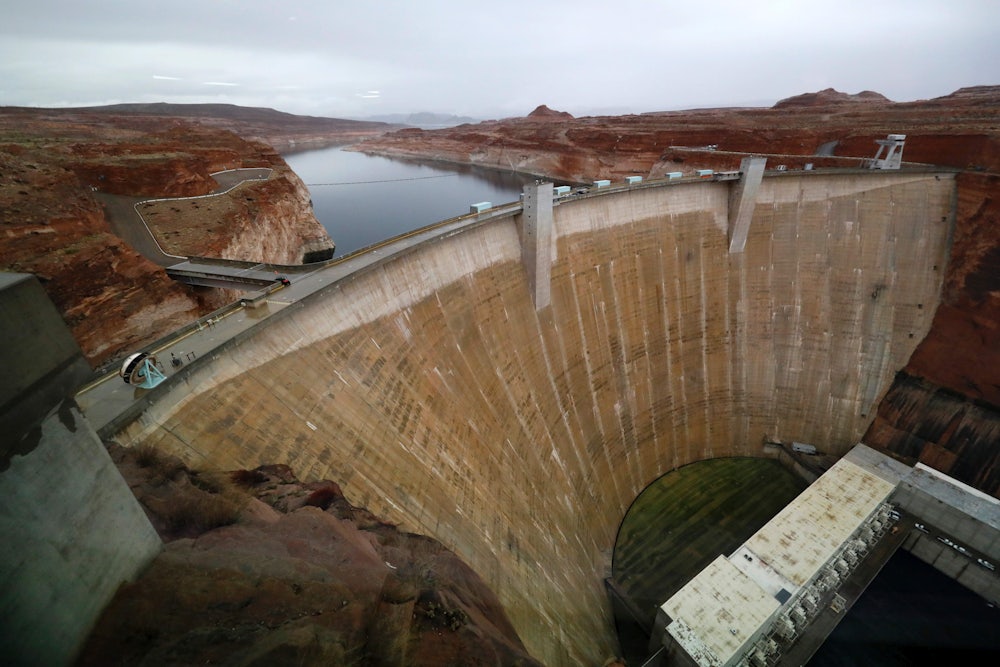The Colorado River supports over 40 million people spread across seven southwestern states, 29 tribal nations, and Mexico. It’s responsible for the irrigation of roughly 5.5 million acres of land marked for agricultural use. Local and regional headlines show the river is in crisis. The nation mostly isn’t listening.
The Southwest is currently in the middle of a drought that began around 2000, which has resulted in weaker downriver flows in both the Colorado River and the Rio Grande. Reports on the issue over the past year from national outlets like The New York Times have focused on explaining the “why” of the problem—walking through how a warm spring in 2020 led to the snowpack in the Rockies melting more quickly and cementing dryer conditions for the coming year, or explaining how the long-term effects from the explosion of global emissions in the twentieth century affect modern-day soil moisture rates. These pieces are crucial, as they help explain how human actions collide with and exacerbate natural trends. But as with any article that ends with a natural resource shortage, on the other side of a scientific explainer story is one that is deeply, unavoidably political.
Developing a coverage model that considers this means making space for both discussions of soil moisture rates and investigative probes into whether tribal, state, and local governments are equitably distributing a limited amount of water. It means having reporters and editors who are comfortable reporting on the ins and outs of climate science, tribal sovereignty, and high-finance models, tracking narratives that are simultaneously hyperlocal and of national significance. It’s also a storytelling problem: Trying to tie the dozens of smaller stories generated by the unfolding disaster into a single, digestible narrative for a national publication is tricky. To get a sense of scale, here’s just a sample of the local stories that have emerged in the past four months.
Inefficiencies and engineering debates plague many cities depending on the river’s water. Last November, a former San Diego city councillor formally began pushing a $5 billion, 130-mile pipeline that would create an alternate route for water from the river to be delivered to the city. The San Diego Union-Tribune reported that proponents believe that though the pipeline would not mean more water for the city, it would ultimately save ratepayers money—currently, the city’s water is delivered via the Los Angeles–based Metropolitan Water District of Southern California, which they claim overcharges the city. But it’s a huge expense, and environmentalists point out that the construction would add greenhouse gases and disrupt the natural ecosystems along the route, which include two national forests.
As city and state governments try to cut costs, tribal governments are working just to get their fair share. In December, as the previous session of Congress was set to expire, the chambers passed a bill that was soon afterward signed by former President Donald Trump, known as the Navajo Utah Water Rights Settlement Act. The legislation settled years-long claims by the Navajo Nation (which covers portions of New Mexico, Utah, and Arizona) for water rights in Utah. The deal secured 81,500 acre-feet of water annually from Utah’s Colorado River Basin and established a $220 million fund to provide clean water to the Diné communities in the state—crucial, given that roughly 40 percent of said households in the state don’t have access to running water or proper sanitation.
As tribal nations take a more active role in the water management that centuries of colonial politics and governmental inaction have denied them, they will likely put their allotments to use—which would affect how much others along the river receive. The Bureau of Reclamation published a report in 2018 known as the Tribal Water Study, which found, among many things, that tribes technically hold the rights to 20 percent of all water in the Colorado River watershed. Complicating this matter, though, is the fact that the tribal nations along the Colorado River may not be as free as, say, a new generation of Wall Street water investors to sell their water rights if they so wished.
In 1908, the Supreme Court ruled in Winters v. United States that despite the formation of Montana as a state, the tribes of the Fort Belknap Reservation were guaranteed a right to “a sufficient amount” of water from the Milk River for irrigation. The court held that the “water of that river cannot be diverted, so as to prejudice this right of the Indians, by settlers on the public lands.” But as Diné geographer and Arizona State University professor Andrew Curley wrote recently, water settlements signed with tribal nations have often been drafted to block tribes from selling their water rights.
Despite these limitations, tribal nations have remained among the proactive in helping the federal, state, and local authorities find solutions to water rights matters amid the drought. Just two years ago, the Gila River Indian Community and the Colorado River Indian Tribes took a leading role in helping Arizona officials negotiate a statewide drought contingency plan regarding future use of water from Lake Mead, which rests just below Las Vegas and is the river’s largest reservoir.
On the other end of the access spectrum, profiteering is already muddying the waters. In early January, The New York Times reported that Wall Street investors have already begun eyeing water scarcity as a potential short- and long-term investment vehicle, a sentence as gross to type as it is to accept. Already, in Arizona, a fight is underway between financial investors and on-river communities, as a Phoenix-based investment group that bought 500 acres of farmland in 2013 and 2014 wants to leave 485 acres of that land dry and sell roughly 678 million gallons of its annual water entitlement to the well-to-do Phoenix suburb of Queen Creek for $21 million. The deal would require the approval of the federal Bureau of Reclamation and is opposed by local government leaders along the river, who believe such a sale would set a precedent for further financial investment in farmlands solely for the ability to profit off water rights—a method known as “buy-and-dry,” per The Arizona Republic.
Since then, a unified front has already formed in Colorado to stave off any leering Wall Street eyes—notable given that the water rights debate is already a fractious one in the state. “We have different interests, and we have different things we use water for on the Western Slope,” Martha Whitmore, the Ouray County board member on the Colorado River Water Conservation District Board, said in a quarterly meeting. “But the one thing we are really unified on … is we don’t want this to be a New York hedge fund’s new thing.”
These stories are just a preview of what is ahead for the Colorado River, and they’ve all played out since November. Many outlets that ostensibly count as national media—the Los Angeles Times, Bloomberg, among others—have published quality coverage of this. Still, it feels odd that the river’s future hasn’t taken up more space as one of the dominating conversations during the Biden administration’s first month. The management of the watershed and the lower and upper basins will dictate how millions of people are able—or not—to live in the places they currently call home for years to come. It’s a problem that will play out in many places as climate change accelerates. But for those along the Colorado, the predictions by climate activists and political scientists—of inequality, of profiteering, of displacement—are no longer hypothetical. They are here, and national media need to figure out right now how to cover them.








